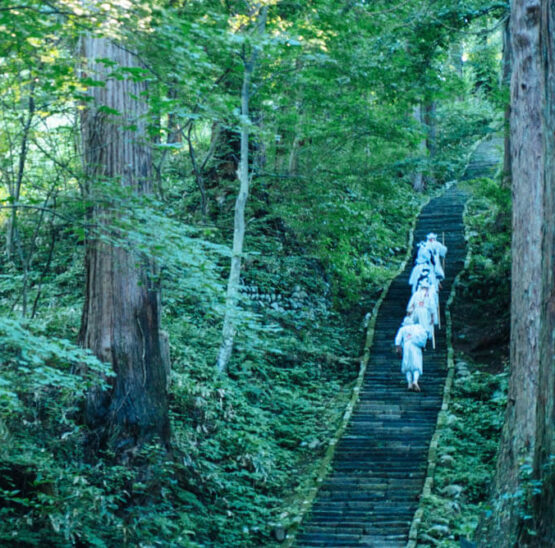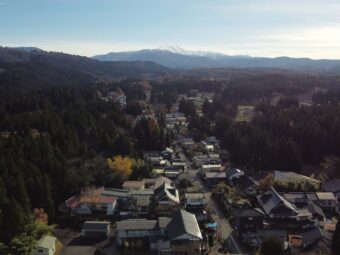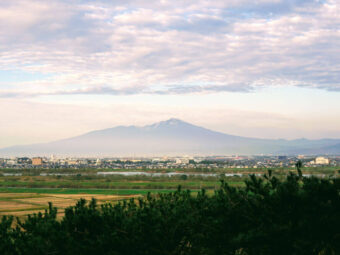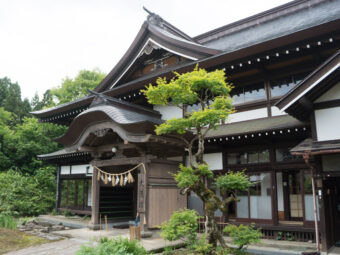MT. GASSAN
Where we encounter our long-lost ancestors and atone for past misgivings
The
pilgrimage
deepens
Representing the past, the looming Mt. Gassan has cast a watchful eye over the Shonai region of Yamagata Prefecture over many millennia. Mt. Gassan is the central stop on the Dewa Sanzan Pilgrimage of Rebirth after the world of the present, Mt. Haguro, and before the world of the future on Mt. Yudono.
Honji Buddha: Amitābha (Amida Nyorai)
The Buddha of Salvation in the Afterlife
Shinto Manifestations: Tsukuyomi-no-Mikoto, the god of the night
Cosmic Time: The Past
Height: 1984m (6509 ft.)
Open: July to mid-October for hiking
April to July for Skiing
Mt. Chokai seen from the Midagahara wetlands on Mt. Gassan
Pilgrim Routes
Learn all you need to know before and during a hike on the Dewa Sanzan.
Tsukuyomi-no-Mikoto is enshrined at Mt. Gassan Shrine at the top
The Border into the Afterlife
There exists a rare belief in the Shonai region named Kannabi Shinko; in which once we pass away, our souls travel to the low-lying mountains, such as Mt. Haguro or Mt. Kinbo, and undertake their own form of training. Under the guidance of 13 Buddha, our souls then spend 33 years travelling higher up the mountains until they reach the top of Mt. Gassan, where they turn into a Shinto Kami god and spend eternity protecting the living. In this way, Mt. Gassan is believed to lie at the border to the afterlife where we can meet out long-lost ancestors.
The Mountain of the Moon
Mt. Gassan is named after the god of the moon, Tsukuyomi-no-Mikoto, with Gassan literally meaning ‘moon mountain’. Tsukuyomi-no-Mikoto's counter-god is his sister Amaterasu Omikami, the goddess of the sun enshrined in Ise Grand Shrine in Mie Prefecture. At the same time, it is said that Buddha’s mantras are projected onto the Dewa Sanzan, with the Midagahara wetlands on Mt. Gassan the home of Amitabha Buddha who represents salvation in the afterlife in Pure Land Buddhism. Before long, Mt. Gassan came to represent the past in the Dewa Sanzan Pilgrimage of Rebirth.
Yamabushi resting during training on Mt. Gassan
What to see on Mt. Gassan
The 8th Station on Mt. Gassan and the Midagahara Wetlands
Mt. Gassan 8th Station
The 8th station on Mt. Gassan marks the starting point for many pilgrims from the Tsuruoka/ Shonai side. When the weather is fine, the view out over the Shonai plains to the Sea of Japan is second to none.
Midagahara Wetlands
The Midagahara marshland behind Mt. Gassan 8th Station is a mysterious place where Amitabha Buddha, the Buddha of Infinite Light in Pure Land Buddhism, is said to reside. Here many rare varieties of alpine plants that bloom throughout the climbing season line the misty path.
Mt. Gassan 9th Station
Busshoike Pond
The 9th Station on Mt. Gassan provides a much-needed rest-spot for pilgrims on the hike to the top. Besides lodging, a variety of snacks, drinks, and other mountaineering equipment is available. Also check out the nearby mystical Busshoike Pond.
Mt. Gassan Shrine
The top of Mt. Gassan holds a special place on the Dewa Sanzan pilgrimage of rebirth as this is where the ancestors are said to turn into gods. On clear days, it’s possible to see out to the Sea of Japan and other mountains in the region, such as Dewa Fuji, Mt. Chokai to the north. Besides shelter, the shrine offers the chance to get purified and to have your walking stick branded with the Mt. Gassan insignia.
Yamabushi training on Mt. Gassan
Mt. Gassan 9th Station in Autumn
Ubasawa
Ubasawa marks the mid-point between inland Yamagata Prefecture and the Shonai region on the coast. Home to the Mt. Gassan Ski Field famously open in the warmer months of April to July, the Ubasawa ski lift is available from April to October making it the shortest path to the top, and is even available after the Autumn leaves have taken command of the hillside.
Mt. Gassan Ski Field
The enormous amounts of snow that accumulates on Mt. Gassan yearly makes for the latest (or earliest) opening time for any ski field in Japan. Open from April to July, when other ski fields close, snow-lovers can enjoy the blue of the summer sky, the white of the snow, and the green of the new summer leaves.
Shizu Onsen
Shizu Onsen on the southern side of Mt. Gassan flourished thanks to its location along the Rokujurigoe Kaido. Surrounded in a forest of beech trees, each lodge provides great views and high-quality onsen water that is great on the skin.
Hijiori Onsen
Hijiori (lit. elbow broken) Onsen is named after a monk who healed his broken elbow in the hot spring water found there. Tucked away in the hills behind Mt. Gassan, and is famous for recording the greatest snowfall of any region in Japan, the path to the top of Mt. Gassan from Hijiori Onsen is the longest and requires one night on the mountain.
View out over the hills behind Mt. Gassan from Hijiori Onsen.
Experiences on Mt. Gassan
Yamabushido Programs
Join the Yamabushido team as they take you on the journey of a lifetime.
Mountain Vegetable and Mushroom Foraging
Try your hand at foraging mountain vegetables or mushrooms on Mt. Gassan with a decadent feast at the end.
Accessing the Dewa Sanzan
Learn all about the best ways to access the Dewa Sanzan with our Ultimate Guide to Accessing the Dewa Sanzan article.
Access Mt. Gassan
The sheer size of Mt. Gassan means that multiple routes to the top are possible, however public transport is limited so it is best to go by private car. The most common starting points are Mt. Gassan 8th Station, Mt. Yudono, and Ubasawa.
The area is also served by public bus.
Maps
Popular Routes up Mt. Gassan
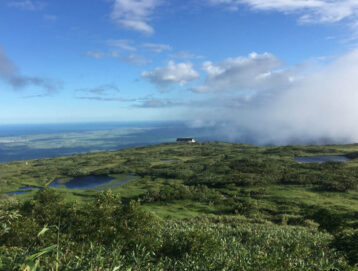
Mt. Gassan 8th Station Return Trip
A return trip from Mt. Gassan 8th station is a great way to explore the mountain, and a great meditative hike. Hikers generally park their cars here or take the bus as they go up past the Midagahara marshlands, Mt. Gassan 9th station, and up to the top. Allow six hours at a regular pace.

Mt. Gassan to Mt. Yudono
For those wanting more of a challenge and to knock off two Dewa Sanzan at once, it's great to hike from Mt. Gassan 8th station to the top, then come back down the path to Mt. Yudono. This does require a bit of co-ordination with busses or private transport, but allows you to take in much more. Allow eight hours at a regular pace.

Ubasawa Return Trip
The Ubasawa Entrance to Mt. Gassan is the preferred route for those coming from inland Yamagata Prefecture. The ski lift here makes the 5km route the shortest up to the top. It’s also possible to walk up from Shizu Onsen meeting the Ubasawa path at Ushikubi. Both routes provide ample opportunity to see the autumn leaves, or even hit the slopes. Allow five hours at a regular pace.

Hiking Mt. Gassan
READ MORE: Hiking the Dewa Sanzan
Unlike Mt. Haguro or Mt. Yudono, a hike up Mt. Gassan is suited to more experienced hikers and is not for the faint-hearted. The shortest routes are about 5km, and take about 4 hours return depending on your pace. The furthest route from Hijiori Onsen is about 20km and requires a night on the mountain.
The weather on Mt. Gassan is extremely unpredictable and can be the complete opposite of that at ground level. As such, it is imperative that you are prepared. At a minimum, proper hiking boots are necessary, as well as waterproof jacket and trousers. Always take plenty of water, at least one litre per person, and have emergency food stocked too.
Depending on the time of year, the path crosses frozen snow that can be extremely slippery, so it is advisable to bring rope with you. Bees, wasps, and mosquitoes are also active, so bug spray and if possible poison remover is a good idea, as well as bringing a bell to scare off bears. We would also recommend a walking stick, such as the Kongodzue used by Yamabushi, as the path can be treacherous at times. Be prepared for steel ladders and tall rocks.
The Pilgrimage Continues
The Pilgrimage of Rebirth continues with a trip to the world of the present on Mt. Haguro, before visiting the world of the future on Mt. Yudono.

Insider information and updates on
The Dewa Sanzan.
Subscribe to the Dewa Sanzan Tribe now.



